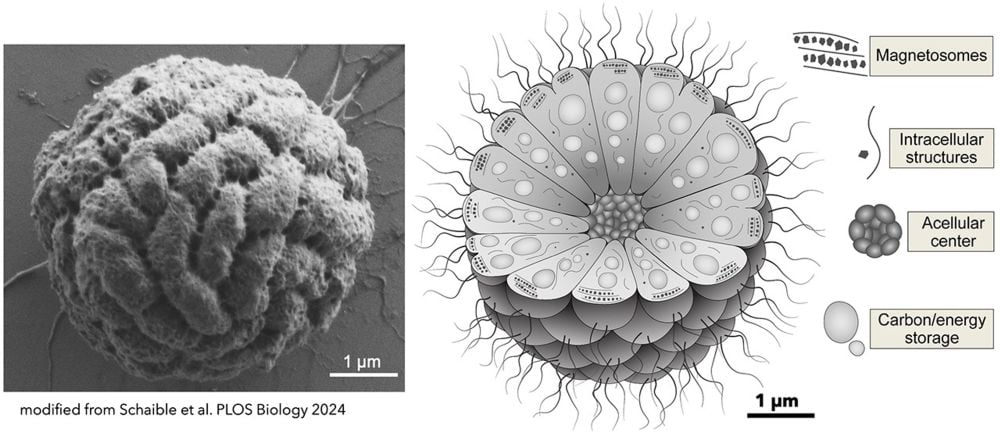Bacteria That Mimic Multicellular Life: A Clue to How Life Evolved
Multicellular magnetotactic bacteria (MMB) are the only known bacteria that group together permanently, forming obligate multicellular consortia. Recent research shows these consortia are genetically diverse and exhibit metabolic specialization between their member cells, offering a unique window into the early steps of multicellular evolution on Earth.
Summary
- MMB use Earth’s magnetic field to navigate, thanks to intracellular magnetosomes.
- They form obligate multicellular aggregates of 15–86 cells that cannot survive alone.
- Genomic studies reveal that cells within one consortium are not clonal but genetically heterogeneous.
- Individual cells take on specialized metabolic roles, such as sulphate reduction or carbon storage.
- MMB consortia are mixotrophic, combining different energy and carbon pathways.
- Research was published in PLOS Biology and funded by NASA’s Exobiology program.
- These bacteria resist cultivation, so most data come from culture‐independent methods and electron microscopy.
- Knowing about MMB helps us see how basic groups of cells might have started complicated life.

How Magnetotactic Bacteria Work
Multicellular magnetotactic bacteria navigate using magnetosomes, tiny iron‐rich organelles encased in lipid membranes. These magnetosomes line up in chains, acting like a compass needle that aligns with Earth’s magnetic field. By following magnetic field lines, MMB optimize their position in sediments where oxygen and sulfide gradients meet.
MMB are found in marine and freshwater sediments, but they are hard to grow in the lab. Scientists rely on advanced microscopy and single‐cell genomics to study them. In one study, researchers sequenced genomes from 22 individual MMB consortia, uncovering eight new species and revealing unexpected genetic diversity within each group.
The Unique Life Cycle
Unlike most bacteria, MMB have no free‐living single‐cell stage. From birth, they exist as part of a tight-knit consortium of up to 86 cells. These cells arrange themselves around a central, acellular compartment filled with extracellular matrix. Each cell has compartments for energy reserves and carbon storage.
| Feature | Single‐Celled Bacteria | MMB Consortia |
|---|---|---|
| Unicellular Stage | Always present | Absent — always multicellular |
| Genetic Uniformity | Clonal | Heterogeneous within one consortium |
| Survival Alone | Yes | No |
| Magnetic Navigation | Rare | Universal via magnetosome chains |
| Metabolic Roles | Generalist | Specialized by cell subpopulations |
Genetic Diversity in MMB
Genomic analyses show that cells within one consortium differ in their DNA sequences, challenging the idea that multicellular aggregates derive from identical clones PubMed. This diversity may help the consortium adapt to changing environments by partitioning tasks among member cells.
“To study the biology of these unique organisms in more detail, we use multiple culture‐independent approaches to analyze the genomics and physiology of MMB consortia at single‐cell resolution,” said George Schaible, lead author of the PLOS Biology study PLOS.

Evolutionary Implications
MMB consortia illustrate a possible early step toward true multicellularity. Scientists theorize three phases in the evolution of multicellular life:
- Adhesion: single cells stick together for shared benefits.
- Communication and cooperation: cells exchange signals and resources.
- Specialization: cells take on different tasks, becoming interdependent.
| Evolution Phase | Description |
|---|---|
| Cell Adhesion | Cells aggregate for protection or resource sharing |
| Communication & Cooperation | Chemical signaling enables group-level responses |
| Division of Labor | Specialized functions arise, leading to true multicellularity |
These phases mirror what is seen in MMB: cells adhere, communicate, and specialize in ways similar to the first steps that gave rise to plants, animals, and fungi.
Broader Impact on Ecology
The rise of multicellular life transformed Earth’s ecosystems. It created new ecological niches, altered the carbon and oxygen cycles, and drove evolutionary innovation. By revealing how simple multicellular groups function, MMB studies help us understand the origins of complex life and guide the search for life beyond Earth. NASA’s support of this research underscores its importance to astrobiology and the quest to find life on other planets.
Facts
- MMB consortia can contain up to 86 cells.
- The acellular center is filled with sticky extracellular matrix.
- Magnetosomes are made of magnetite or greigite minerals.
- Some MMB species glow under certain light due to unique pigments.
- Cells communicate using tiny molecular signals.
References
- NASA Press Release: NASA Research Examines the Multicellular Behavior of Unique Bacteria NASA Science
- Schaible GA, et al. “Multicellular magnetotactic bacteria are genetically heterogeneous consortia with metabolically differentiated cells.” PLOS Biology PLOS
- Cockerill J. “Strange Bacteria That Can’t Live Alone Hint at Early Steps to Complex Life.” ScienceAlert. ScienceAlert
- Universe Today. “Bacteria That Can Mimic Multi‑Cellular Life.” Universe Today
- Phys.org. “Unique bacteria that survive by employing multicellular behavior offer clues to life’s evolution.” Phys.org

